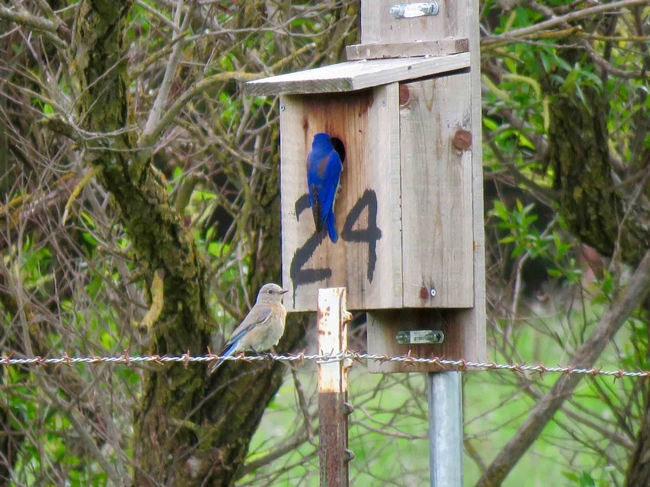Guess what? Recent scientific studies have confirmed that seeing and hearing birds makes people happy! Science is just beginning to back up something we humans have intuitively known for a very long time. A case in point is the bluebird, which has symbolized happiness in cultures around the globe for centuries.
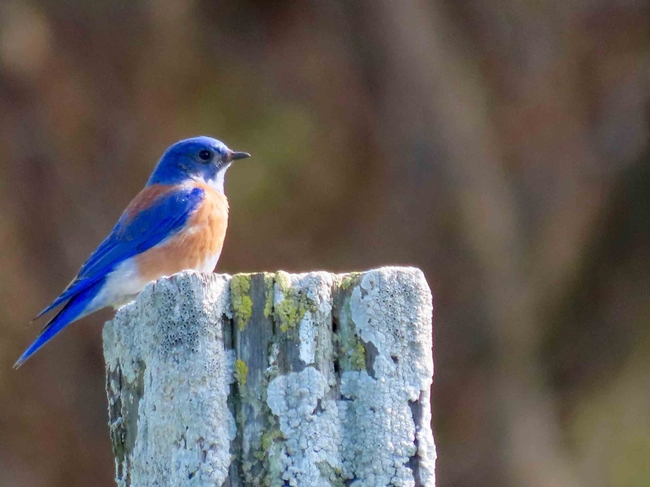
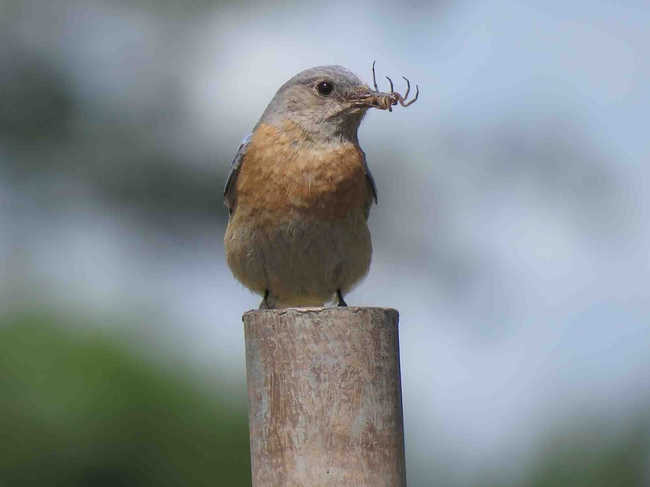
Western Bluebirds frequent forest edges and open understories that provide the visibility they need to hunt for food. They find foraging grounds in parks and schoolyards, and along field edges and golf courses. They hunt by dropping from low perches to the ground to capture invertebrate prey. Their summer diet, which consists primarily of insects, makes them excellent allies for the home landscape and garden; they will eat many beetles and caterpillars considered pests of garden and agricultural crops, as well as those pesky mosquitoes. Studies of their pest-eating potential confirm that they reduce insects on vegetation significantly and show promise as natural pest control agents in commercial vineyards and orchards as part of an Integrated Pest Management (IPM) program.
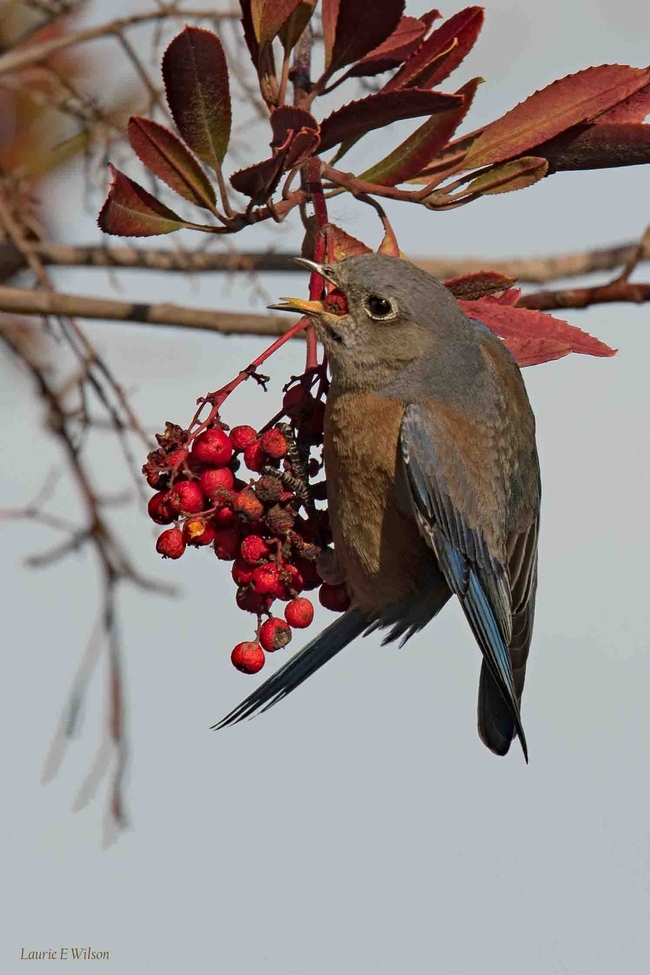
In winter, Western Bluebirds flock up and migrate short distances to take advantage of the seasonal availability of small fruits and berries, and some seeds. Among the native berry producing plants they prefer are mistletoe, Toyon (Christmas berry or California holly), elderberry, California grape, serviceberry, redberry, juniper, and even poison oak. You can enhance the attractiveness of your landscape to bluebirds by providing a year-round water source and native plants bluebirds will eat in winter. Additional plants they may feed on include dogwood, Pacific madrone, cherries (Prunus species), figs, California rose, California buckthorn, wax myrtle, manzanita and lantana.
Another way you can enhance your property's potential to harbor bluebirds is to provide artificial nesting sites. As secondary cavity-nesters, bluebirds are unable to excavate their own nest holes but must rely on cavities created by other animals or the elements. Removal of dead and dying trees, both for construction and due to uncontrolled wildfires, has contributed to declines in populations of bluebirds and has affected many other cavity-nesting bird species, some of which compete with bluebirds for nest sites. Be sure to check your ailing trees for nest cavities before you remove them and, if you happen to see bluebirds in your yard or immediate neighborhood or think you have good habitat, please consider putting up a nest box to help them. If you have more than an acre of property, you may have room for several nest boxes or even a bluebird nest box trail. Due to territoriality, bluebirds will not nest near other bluebirds so if you do install more than one nest box don't expect more than one bluebird pair unless you have room to leave 200-300 yards between boxes. Pairs of boxes as close as 15 to 20 feet of one another can provide nesting sites for a bluebird pair and a pair of Oak Titmice or Tree Swallows (reducing their competition for nesting sites where natural cavities are scarce).
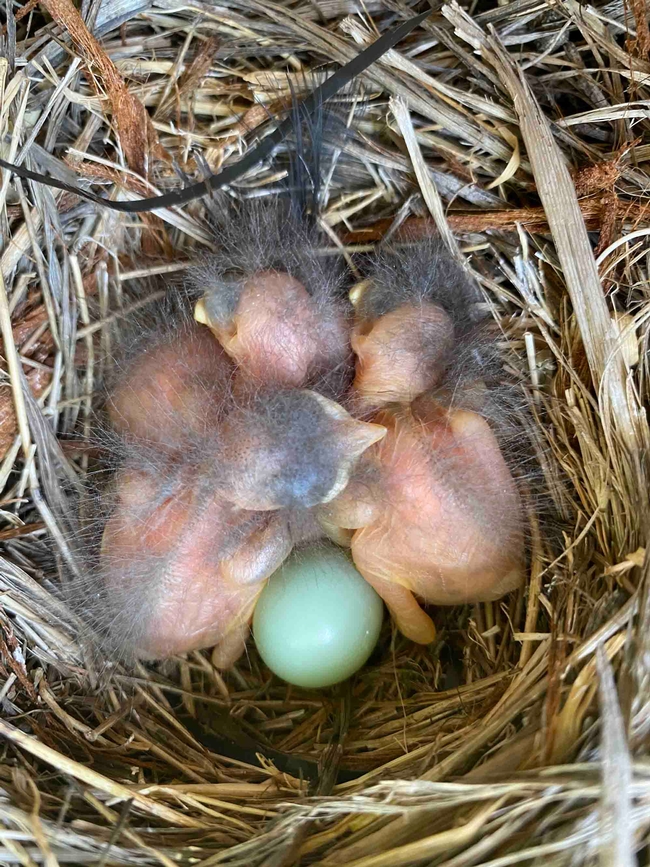
Nest Box Guidelines for Western Bluebirds
- Use untreated pine or redwood (old fence boards can be upcycled into nest boxes).
- Keep the color and look natural and forego an outside perch; birds need camouflage to avoid predation and perches allow avian predators easier access to eggs and young.
- The box should be eight to 10 inches deep, with an interior cavity about five and one-half inches square; the entrance hole should one and one-half inches in diameter, placed seven inches above the floor.
- Provide insulation to keep nest boxes cool in summer and warm in winter by making sure the nest box sides are at least three-quarters of an inch thick.
- Ventilation space under the roof and holes in the bottom corners will keep birds cool in summer and dry during rains.
- Rough grooves under the nest hole on the interior surface help the birds climb out.
- A side that opens provides easy access for monitoring and cleaning out old nests after each brood fledges.
- Mount the box at least five feet above the ground on a pole, if possible. Boxes can be attached to trees and fences, but this kind of setup will allow predators easier access to the box.
- To keep out pole-climbing predators (like raccoons), your nesting box needs an overhanging roof, a wire cage around the entrance hole, and a predator baffle. Here are some instructions for creating a baffle: PREDATOR BAFFLES: Easy, Inexpensive and Effective, Bluebird Conservation.
- Place nest box out of wind and extreme sun, and away from busy areas or terrain that will be mowed, in order to keep disturbance to the birds low.
- Keep the nest box pointed toward cover like shrubs or trees but clear of vegetation so the adult birds have easy access.
- Monitor your nest box for signs of active nesting (usually occurring between March and July) and consider becoming a citizen scientist to share your observations (see how below).
- Leave nest boxes up year-round as bluebirds may shelter in the box in winter.
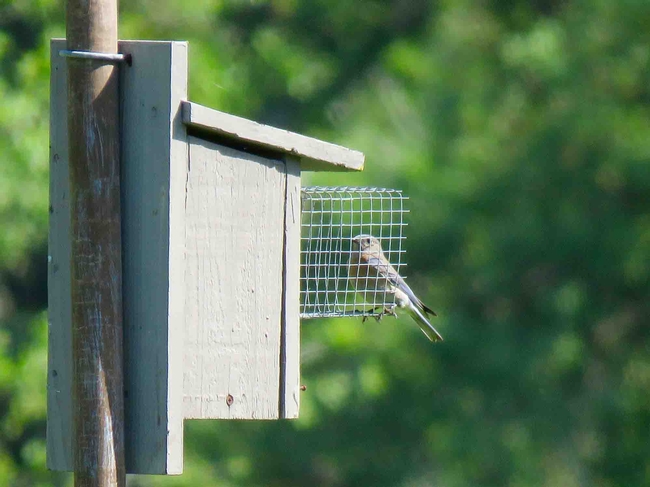
Finally, you can contribute to citizen science by gathering data on the use of your nest box by birds and sharing it with both the CBRP and the Cornell Lab of Ornithology's Nest Watch program, an activity sure to bring happiness to the young and old alike.
Let's Bowl! The University of California Cooperative Extension (UCCE) in Butte County works to address the needs of Butte County residents like youin a variety of ways, including 4H, farm advisors, nutrition and physical activity programs, and Master Gardeners. The Support Group of Butte County UCCE will host its 18th Annual Bowl-A-Thon and Silent Auction on Saturday, March 12, 2022 from 6:00 to 9:00 pm. Join us for an evening of fun! Get together with friends and family to form a team of four bowlers; for a contribution of $300 per team, each bowler will receive three games of bowling and free shoe rental. More information can be found on our webpage or call the UCCE Office at (530) 538-7201.
Your tax-deductible donation will support UCCE programs and activities in Butte County.
UC Master Gardeners of Butte County are part of the University of California Cooperative Extension (UCCE) system. To learn more about us and our upcoming events, and for help with gardening in our area, visit our website. If you have a gardening question or problem, email the Hotline at mgbutte@ucanr.edu (preferred) or call (530) 538-7201.
